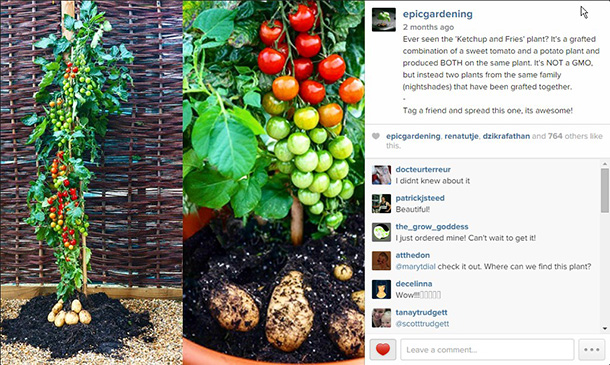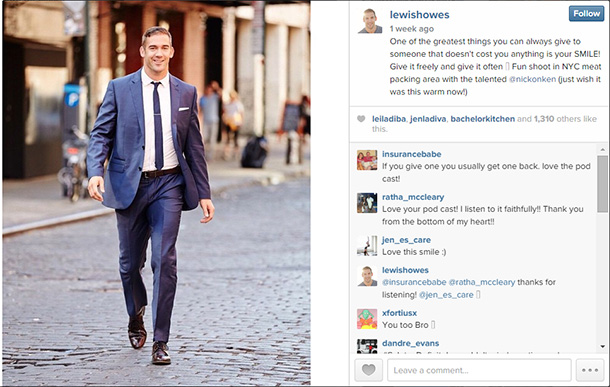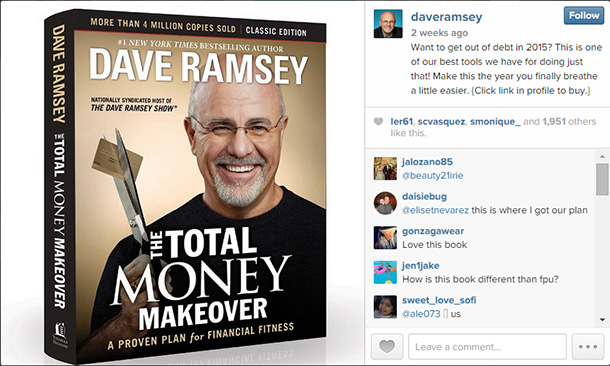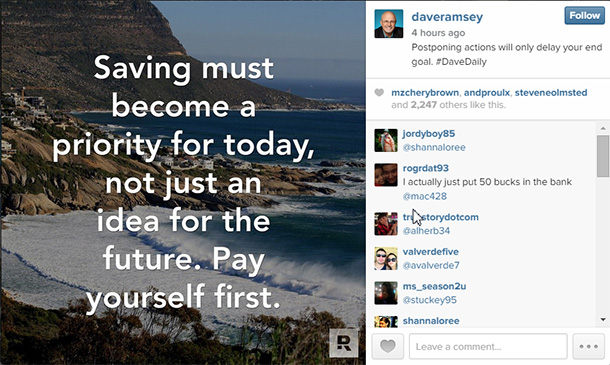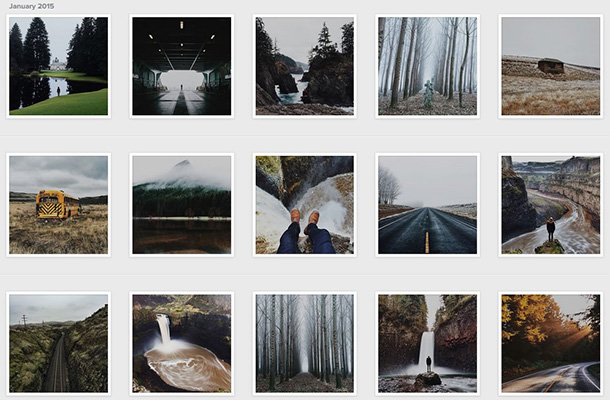*Note: I originally wrote this piece for SEONick, which is a fantastic blog that you should probably check out (after you read this post)*
There are a lot of marketing articles about Instagram. Or any other “social media channel”, “online platform”, or “inbound marketing target.”
This is going to be another one of those, but with a little twist.
I’m going to tell you everything I did to grow a brand on Instagram, down to the daily tasks – but I’ll talk a little high level as well.
I feel that too many marketing blogs, articles, and ULTIMATE GUIDES gloss over the reason you’re doing any of this stuff – to connect with your customers, provide as much value as humanly possible, and build a strong, thriving community.
The Brand
For this experiment, I chose a site that I built as a pet project years ago, called Epic Gardening.
I built it because I have a strange, weird addiction to gardening and cultivating my own food, but also because every gardening site that I read for information looked like it was still running on Geocities or Angelfire.
I worked on it on and off as I had other things going on in my life, but decided to apply some marketing systems that I’d built for clients to it to see if they’d work, and they did.
I chose Instagram as a platform because gardening is an inherently visual niche that’s ripe for amazing photography – Instagram is the place for amazing photography.
Here are the results that I have achieved thus far:
Epic Gardening Results
- Account Created: January 6, 2015
- Followers: 10,850 (~124/day)
- Total Photos: 127
- Total Likes: 62,661
- Total Comments: 2,308
- Brand results outside of Instagram:
- Increased traffic to the Epic Gardening website (caused some old posts to go viral and 4x my monthly traffic from 15,000 to 60,000/mo)
- Increased following on Twitter, Pinterest, Facebook
- Boosted credibility for partnerships with larger gardening brands
The Process In a Nutshell
- Finding people with a large following of our target demographic.
- Analyzing their accounts to see what they share and how they share it.
- Developing a repeatable, automatable strategy for connecting with the people that follow those accounts.
- Layering on levels of engagement to make sure the audience we’re building cares about us and our brand, and visa versa.
Define Your Ideal Follower
We need to get in the right mindset before we start on Instagram. We need to know exactly what type of person we are trying to attract to our brand.
THIS IS THE MOST IMPORTANT STEP.
If you’re not willing to put in a few hours of upfront research, there’s really no point in reading the rest of the guide – it’s going to set the stage for every other decision you’ll make down the road.
As someone who loves tactics and strategies, it’s hard for me to sit down and do the research and digging, but it’s well worth it (just look at the numbers above).
- Exactly what type of person do you want to attract?
- What successful accounts are they already following in your niche?
- What types of photos are they liking?
- What hashtags are they using on their own photos?
- What are the hashtags successful accounts in your niche are using?
These questions need to be answered in extreme detail…so do the work!
How You Can Interact on Instagram
Instagram is a fairly simple social media platform. There are only a few ways to interact:
- Like or unlike a user’s photo
- Follow or unfollow a user’s photo
- Direct message a user
- Tag a user in a photo
- Comment on a user’s photo
- Use hashtags
- Mention a user by their profile name
Liking
This is one of the simplest growth methods on Instagram. Everyone wants more likes on their photos – we’re all subject to our own egos.
However, because it’s so easy to do, the value of the action is low. For accounts with a lot of followers, liking often won’t have much of an effect as your like will be buried in the massive sea of likes that they get.
However, liking photos should be part of your overall growth strategy.
Following
Following is one of the easiest ways to get individual attention on Instagram. In the notification feed it shows up as a separate line item, meaning it can’t get drowned out or grouped with other actions.
It also shows up separately in push notifications as well if the user still has those active.
Tagging
Tagging shows a user’s username in your photo if it’s tapped on. The user also gets a notification that, like a follow, is a separate push notification and line item in their activity feed.
However, this should only be reserved for accounts that you know personally. It’s bad form and very spammy to tag people you don’t know in your photos.
Commenting
A higher-touch, but higher-effectiveness strategy. When automated, this will come off extremely spammy and put your account at risk, so it’s not really worth it, unless you do it very selectively and very carefully.
It’s possible to give a genuine, flattering comment and do it at scale.
Whatever you do, do not advertise or sell yourself in any way in your comments.
Direct Messaging
Sends a photo with a message to a single user.
This should be kept for private communication among followers that you know well, or followers that have commented a lot and you want to reach out to personally with a call to action.
Hashtags
I’ve saved hashtags for last because they’re one of the least effective ways to grow your following that I have tested.
They’re one of the most over-emphasized growth tactics, and in my opinion are best used in the research and audience building phase rather than spamming them on your photos. If you do use hashtags, the best thing to do is to “claim” a hashtag that has to do with your brand.
For me, the choice was obvious: #epicgardening. When I first started using this hashtag, there were 134 photos with the tag on Instagram.
There are now 4,500 photos tagged with #epicgardening. It’s one of the ways that I connect with my audience – I like and comment on photos that use the branded hashtag.
Mentioning a User
Mentioning a user can be done in the comments or in the photo description. It’s most often used by friends to let another person know about a photo that’s relevant. Think Dan Bilzerian on Instagram – over half of the comments on any photo he shares are people mentioning other people.
It’s best to use this sparintly – like tagging. Don’t do it unless you know the person or have a good reason (we’ll get into that later).
Engagement: There’s No Point In A Dead Following
Ever see those accounts with 10k followers, 100 likes per photograph, and 1-2 comments? That’s a worthless account. Take 9,000 off of that number and you’ll be closer to the true amount of followers that they have.
Your goal in the research phase of setting up your brand on Instagram is to figure out where the most engaged people are – who they follow, what hashtags they use, and what photos and content they absolutely love. Produce that and add in a few of the strategies below and you’ll be on your way to a highly engaged brand.
This is what engagement looks like (there are 98 comments on this photo):
Encourage Them to Add Their Own Hashtags
Spamming the photos you post with a bunch of hashtags at the end of the description isn’t necessarily ineffective, but it’s in bad taste and is viewed poorly by your followers.
A slightly better approach is to ask your followers to add their own hashtag to your photos with a CTA in the photo description.
“Claim” a Hashtag
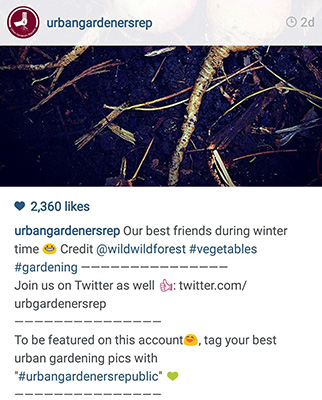
A great way to get your following hyper-engaged is to claim a hashtag as your own and encourage your followers to post photos to their OWN accounts using that hashtag.
A great example of this is http://instagram.com/urbangardenersrep – they’ve effectively claimed the #urbangardenersrepublic hashtag and get a ton of people in their audience to post photos that they then repost with credit. It’s a great way to inspire engagement.
Get Them to Tag Someone They Know
If you post a photo that is extremely interesting to your following, they may decide to tag some of their friends that they feel would also enjoy the photo. One of the best examples of this isDan Bilzerian’s Instagram.
Since not all of us are multimillionaires, poker players, and gun enthusiasts all rolled into one, you may want to resort to giving a call to action to encourage your following to tag a friend like Lewis Howes:
In this quote photo he’s sharing something about his own personal life (connection with followers), indirectly asking them to comment (cta for engagement), and asking them to tag a friend who ‘always defies the odds’ (cta for growth)
Encourage Them to Like Your Photo
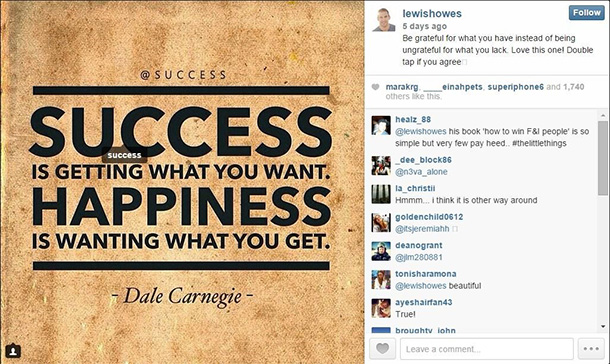
If you want a chance to get into Instagram’s updated Explore tab (which is much more accessible than it used to be), getting likes in the first 30 minutes of a post’s existence is crucial.
A lot of top Instagram accounts do this with a call to action in the description, usually saying something like, “Double tap if you agree!” This creates a bit of cognitive dissonance in a follower’s brain because the quote is something very hard NOT to agree with, if you want to think of yourself positively.
Encourage Them to Click Link in Your Profile
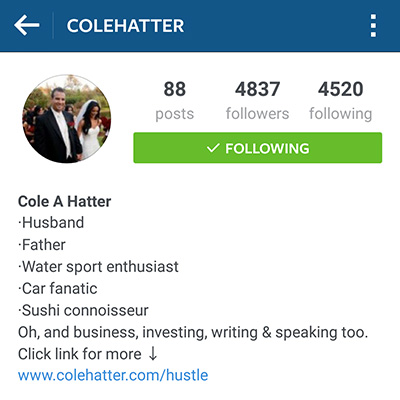
Instagram doesn’t (yet) allow you to share clickable links in photo descriptions, so your best bet if you want someone to move from Instagram to somewhere else is to direct people to your profile and update your link.
For example, Lewis Howes, who runs a podcast for entrepreneurs called The School of Greatness, will update the link in his Instagram profile to the show notes for the latest episode in order to promote the most timely piece of content that he has to offer his audience.
Types of Media to Share
We’ve covered research, ways to interact, and engagement strategies…but what about the actual content that you post? I’ve saved the best for last as most people really, really mess this up.
There are certain types of photos that do extremely well on Instagram, and certain photos that absolutely suck. Here’s a brief overview of the ‘genres’ of photos that you can and should consider posting to the account.
Lifestyle Photo
The lifestyle photo works well for accounts that are promoting a way of life, whether it be the entrepreneurial journey, the yogini lifestyle, or healthy habits.
It’s non promotional, and usually carries with it an aspirational message that is trying to convey that your followers can also achieve this lifestyle. If not that, then it offers a positive quote or message, like you see in Lewis Howes’ here:
One of the greatest things you can always give to someone that doesn’t cost you anything is your SMILE! Give it freely and give it often.
Promotion Photo
Every now and then, you’ll want to mix in photos that promote your brand. It’s important to make sure that the offer and message are closely related to what a large percentage of your followership needs.
In this example, Dave Ramsey is promoting one of the lower-end offers that he has, telling people to click the link in his Instagram profile to pick it up.
His call to action works here because it’s timely (this was around New Years = financial resolutions) and he’s offering a solution to a very painful problem (getting out of debt).
On top of that, the image takes up most of the screen on Instagram and is an extremely high quality book image, versus a trashy eBook cover or 3d generated model that so many people use.
Quote Photo
If you’re running a profile that’s trying to convey a specific message, whether that be something global (motivation) or specific (finances), quote images are an amazing way to get a lot of engagement and organic growth.
By their nature, quotes are inspirational and aspirational and will entice a lot of your followers to @mention other people in their network that they think the quote would help.
In this example, Dave Ramsey is making full use of the quote image with a branded quote that’s probably coming directly from one of his books. All of his quote images have the same styling, so people scrolling through quickly will know:
[GREYED OUT BACKGROUND + WHITE TEXT + R IN BOTTOM RIGHT CORNER] = Dave Ramsey quote.This inspires them to stop vertically scrolling because they like the brand, and give the photo a like or @mention a friend.
Here, Dave is also using a claimed hashtag of #DaveDaily that lets new people know that he posts these every day as well as including some more personal branding.
Niche Photo
These photos should make up the bulk of your profile if you’re in a focused niche.
How Cohesive Is Your Feed?
It’s very important to post photos that all have the same “flavor”, meaning that when you look at your Instagram profile page, all of the photos look like they belong together.
Too many brands post amazing photos on an individual level that look ridiculous when viewed in the feed.
A jumbled mess of colors, patterns, and distances that make the feed look disorganized and busy. When someone is making that 1-2 second decision to follow you or not, they’re not looking to see if your photo is cool – they’re looking to see if your FEED is one they’d want to see on a daily basis.
This is the profile page of a photographer with 30k followers. He posts amazing photos, but as you can tell they all have the same type of vibe.
They’re all landscapes of some kind, usually with a focal point in the middle of the photo (line of trees, road, waterfall), and they are all taken on cloudy days, so the general color palette of his feed is very similar picture to picture.
Shoot for this type of ‘feel’ to your feed when you look at it quickly. Not the exact style, but the feeling that everything goes together.
A Recipe For Growing Your Account
This can be very tedious, but if your brand is well suited to Instagram, this work will pay dividends. Below is a rough outline of the type of work that I did to build Epic Gardening to over 10,000 followers in around 3 months.
Following
The follow is one of the strongest actions you can take to grow your Instagram account. Because it shows up separately on your activity feed, following someone will grant you a millisecond of a potential follower’s attention.
So far, the most effective following strategy I have tested is picking 1-3 accounts that are similar to your account and popular. Then, scrape their followers and start following them.
Generally you want to stagger your following efforts so you don’t hit Instagram rate limits, so anywhere from 450-650 a day is a good target. Use something like Iconosquare to do this on the web so your life doesn’t suck.
Liking
Liking photos is much lower value than following, but it’s still effective to use. It still shows up separately in your activity feed, but can easily get drowned out by a large swarm of other likes.
The best way to use liking for growth is to figure out ~5 hashtags that the people you want to follow you are using the most, then like a lot of those photos per day.
Pro Tip: Use the “Power Punch” combo: Follow + Like + Like + Like. This takes up half of their screen and shoots followbacks up from a dismal sub 10% to around 25% if you have a solid feed.
Commenting
Moreso than following, comment almost always spurs engagement.
It’s a very personal thing for someone to take the time to comment on a photo that you have taken, and most Instagram users are very thankful. That, and they’ve got an ego and are trying to build their platform too, so any compliment is going to rub them the right way.
Commenting on the 1-3 best hashtags at a rate of 100-150 a day is a great way to grow engagement and followers.
Typically I like to go with a simple compliment that is templated so I’m not posting the exact same text everywhere.
Note: it’s not automated, just ‘spun’ in the sense of using different words to say more or less the same thing. I keep all of these variations in my notes app on my phone.
Here is a template:
<@owner> this {shot | photo | picture | images | snap | insta | photograph} is {breathtaking | amazing | incredible | lovely | marvelous | stunning | awesome | fascinating | badass | rad | epic}!
*If using a spinner you will likely need to remove all spaces, I’ve just added them here to maintain mobile responsiveness.
A Simple Daily Routine
If you want to go hardcore, this is a great way to do it. It will take some time and effort, but if you’ve identified Instagram as a great place for your brand to expand to, then it’ll be worth the time.
For Epic Gardening, I’ve lined up a ton of interest from gardening product creators to the point that I have a free giveaway of a product in the $100-$500 range scheduled for every month of this year already.
Running online giveaways for those has expanded my list, traffic, and every social channel immensely. So the manual effort of building Instagram was most definitely worth it.
- 450-650 follows
- 1500-2100 likes
- 100-150 comments
- 500 unfollows (if not following back – this keeps your ratio at least 1:1)
Go Forth and Build
Hopefully you got some value out of this post – I tried to make it as extensive as I could, but I’m sure that I missed a bunch of little things that I do to make my Instagram brand growth as simple and easy as possible.
Feel free to reach out to me via email, comment, or social media if you have any questions or comments about this piece. Now, go forth and build your #brand!
– Kevin
The post How to Grow a Brand on Instagram appeared first on Supreme Strategies | San Diego Inbound Marketing.
